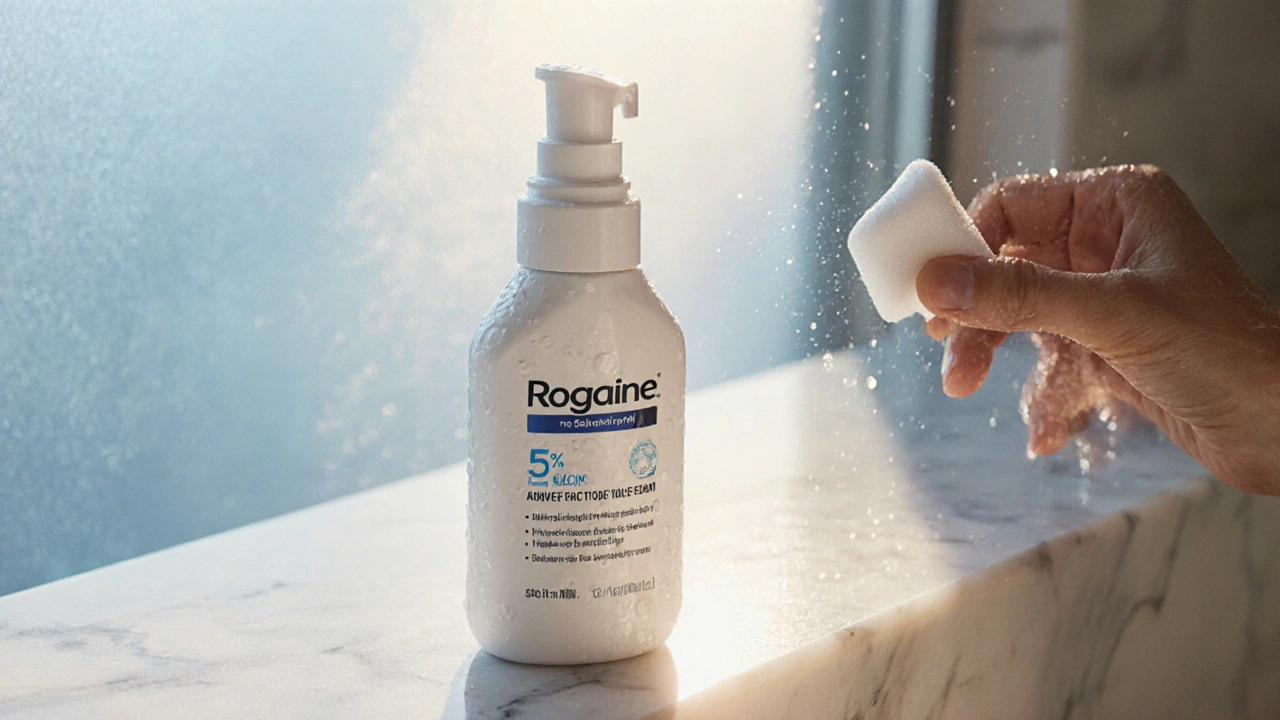
Hair Loss Treatment Comparison Tool
Rogaine 5% Minoxidil
Active Ingredient: Minoxidil 5%
Effectiveness:
Side Effects:
Monthly Cost: $45
Prescription: No
Generic Minoxidil
Active Ingredient: Minoxidil 5%
Effectiveness:
Side Effects:
Monthly Cost: $15
Prescription: No
Finasteride 1mg
Active Ingredient: Finasteride
Effectiveness:
Side Effects:
Monthly Cost: $30
Prescription: Yes
Nutrafol
Active Ingredient: Nutraceutical blend
Effectiveness:
Side Effects:
Monthly Cost: $80
Prescription: No
Pumpkin Seed Oil
Active Ingredient: Pumpkin seed extract
Effectiveness:
Side Effects:
Monthly Cost: $20
Prescription: No
LLLT Device
Active Ingredient: Red light therapy
Effectiveness:
Side Effects:
Monthly Cost: $120 (One-time)
Prescription: No
Hair Transplant
Active Ingredient: Surgical grafts
Effectiveness:
Side Effects:
Monthly Cost: $4,000-$8,000 (One-time)
Prescription: Yes
Decision Matrix
Use these criteria to choose your best option:
- Budget-First? Choose generic minoxidil ($15/month).
- Maximum Growth Needed? Combine finasteride with minoxidil or opt for hair transplant.
- Prescription Aversion? Try natural supplements or LLLT devices.
- Concern About Side-Effects? Stick to topical treatments or low-risk natural options.
- Long-Term Commitment? Minoxidil requires daily use; transplants are permanent.
Hair thinning can feel like a silent confidence thief, and the market is flooded with products promising a miracle. But which one truly delivers? This guide dives deep into Rogaine vs alternatives, breaking down effectiveness, safety, price, and everyday practicality so you can stop guessing and start choosing.
Key Takeaways
- Rogaine 5% is the most clinically proven OTC minoxidil solution, but its results plateau after 6‑12 months.
- Generic minoxidil matches Rogaine in efficacy while cutting cost by up to 70%.
- Finasteride offers stronger results for men but requires a prescription and carries systemic side‑effects.
- Natural extracts (pumpkin seed oil, saw palmetto) are safe but deliver modest gains.
- Low‑level laser devices and hair‑transplant surgery provide the highest hair‑density outcomes but differ wildly in price and commitment.
What Is Rogaine 5% Minoxidil?
When it comes to over‑the‑counter hair regrowth, Rogaine is a 5% minoxidil topical solution approved by the FDA for both men and women with androgen‑dependent alopecia. Launched in the late 1980s, the product works by widening blood vessels around hair follicles, delivering more oxygen and nutrients that prolong the growth phase (anagen) of the hair cycle.
Rogaine is sold in two formats: a liquid that you spray onto the scalp and a foam that some users find less greasy. Both require twice‑daily application for at least four months before any visible change appears.
How Minoxidil Works - The Science in Plain English
Minoxidil was originally a blood‑pressure medication. When researchers noticed unexpected hair growth in patients, they repurposed it for dermatology. The molecule acts as a vasodilator, opening up tiny capillaries around the follicle. More blood flow means more nutrients, which can revive follicles that have entered the miniaturization stage.
Clinical trials consistently show that about 40‑60% of men and 30‑45% of women using 5% minoxidil see a measurable increase in hair density after 12 weeks. The effect is measurable but not dramatic; users typically gain 10‑20% more hairs in the treated area.
Popular Alternatives to Rogaine
Below are the most widely used competitors, grouped by mechanism of action.
- Generic Minoxidil - identical active ingredient, sold by pharmacies at a fraction of the brand price.
- Finasteride - an oral 1mg prescription that blocks DHT production, the main hormone behind male pattern baldness.
- Nutrafol - a nutraceutical blend containing biotin, saw palmetto, and botanical extracts aimed at supporting scalp health.
- Pumpkin Seed Oil - a natural oil taken orally, suggested to inhibit 5‑alpha‑reductase activity.
- Low‑Level Laser Therapy (LLLT) Devices - handheld caps or combs that emit red light to stimulate follicles.
- Hair Transplant Surgery - a permanent solution that relocates donor follicles to balding zones.
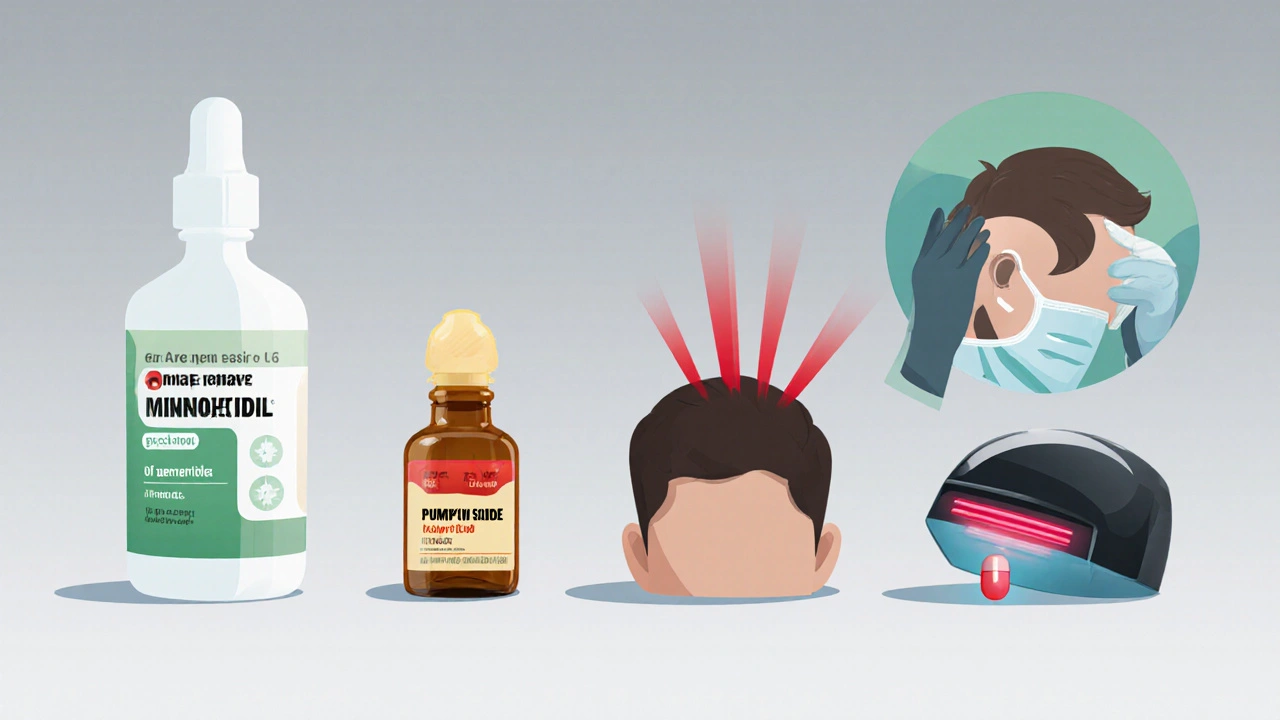
Side‑Effect Profile at a Glance
Understanding potential downsides helps you weigh risk versus reward.
- Rogaine / Generic Minoxidil: scalp irritation, itching, and occasional unwanted facial hair growth.
- Finasteride: sexual dysfunction, mood changes, and a rare risk of high‑grade prostate cancer.
- Nutrafol & Natural Oils: generally mild; occasional digestive upset.
- LLLT Devices: negligible side‑effects, occasional scalp warmth.
- Hair Transplant: surgical risks - infection, scarring, temporary shock loss.
Cost Comparison - What Will Your Wallet Feel?
| Product | Typical Monthly Cost (USD) | Effectiveness Rating* (0‑5) | Side‑Effect Rating (0‑5, lower is safer) | Prescription Needed? |
|---|---|---|---|---|
| Rogaine 5% Foam | $45 | 3.5 | 2.0 | No |
| Generic Minoxidil (liquid) | $15 | 3.5 | 2.0 | No |
| Finasteride 1mg | $30 (insurance may reduce) | 4.5 | 3.5 | Yes |
| Nutrafol Men’s Formula | $80 | 2.5 | 1.0 | No |
| Pumpkin Seed Oil Capsules | $20 | 2.0 | 0.5 | No |
| LLLT Cap (e.g., iRestore) | $120 (one‑time) | 3.0 | 0.5 | No |
| Hair Transplant (FUE) | $4,000‑$8,000 (one‑time) | 5.0 | 2.5 | Yes |
*Effectiveness rating reflects average hair‑count increase per clinical studies. Side‑effect rating balances frequency and severity.
Choosing the Right Solution for You
There’s no one‑size‑fits‑all answer. Consider the following decision matrix:
- Budget‑First? If money is tight, generic minoxidil gives you the same active ingredient at a fraction of the price.
- Maximum Growth Needed? Men with advanced thinning often see the biggest jump with finasteride plus minoxidil or a hair‑transplant.
- Prescription Aversion? Natural supplements and LLLT devices keep you drug‑free, though expect slower, subtler results.
- Concern About Side‑Effects? Stick to topical treatments (Rogaine, generic) or low‑risk natural options.
- Long‑Term Commitment? Minoxidil requires daily application indefinitely; surgical grafts are permanent but costly.
Many users adopt a hybrid approach-using minoxidil daily while taking a low‑dose finasteride at night. This combo has shown a synergistic lift in several dermatology clinics.
Practical Tips & Common Pitfalls
- Give It Time. Visible regrowth rarely appears before 12 weeks. Patience beats premature switching. \n
- Apply to Dry Scalp. Wet hair dilutes the solution and reduces absorption.
- Don’t Trim Too Much. Cutting hair too short can make early growth look like shedding.
- Watch for Unwanted Facial Hair. If you notice stray hairs on cheeks, reduce dosage or switch to foam.
- Check Interaction with Other Topicals. Retinoids can increase irritation; space applications by at least 30 minutes.
Frequently Asked Questions
Can I use Rogaine and finasteride together?
Yes. Dermatologists often prescribe both because minoxidil stimulates growth while finasteride blocks the hormone that shrinks follicles. Using both can boost hair count by up to 25% more than either alone, but monitor for side‑effects.
Is generic minoxidil truly as good as Rogaine?
Clinically, yes. The only difference is the inactive ingredients and brand packaging. Many users report identical results when the concentration is the same (5%).
How long should I stay on minoxidil?
As long as you want to maintain the regrown hair. Stopping the treatment usually leads to shedding of the new growth within three to six months.
Are natural oils like pumpkin seed oil effective?
Research shows modest improvement (about 10% increase in hair density) in men who take 400mg daily for 24 weeks. They are safe but not a replacement for FDA‑approved meds if you need strong results.
What’s the best age to start a hair‑loss regimen?
Most experts suggest beginning at the first sign of thinning, typically in the late 20s to early 30s for men and mid‑30s for women. Early intervention preserves more follicles.
Whether you choose the tried‑and‑true Rogaine, a cheaper generic, or a completely different route, the key is consistent use and realistic expectations. Armed with the facts above, you can pick the option that matches your budget, risk tolerance, and hair‑goals.

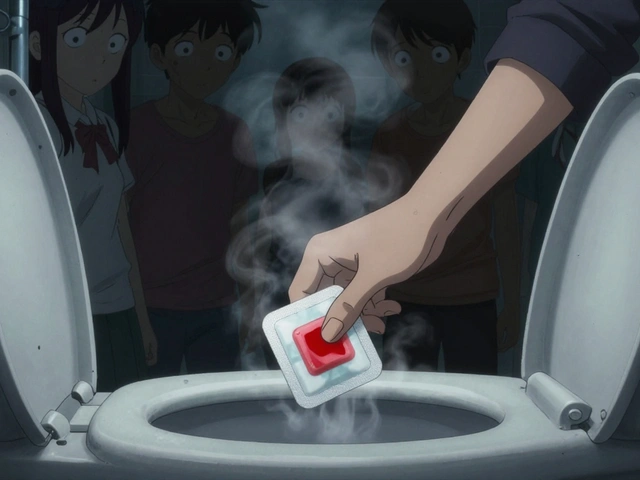
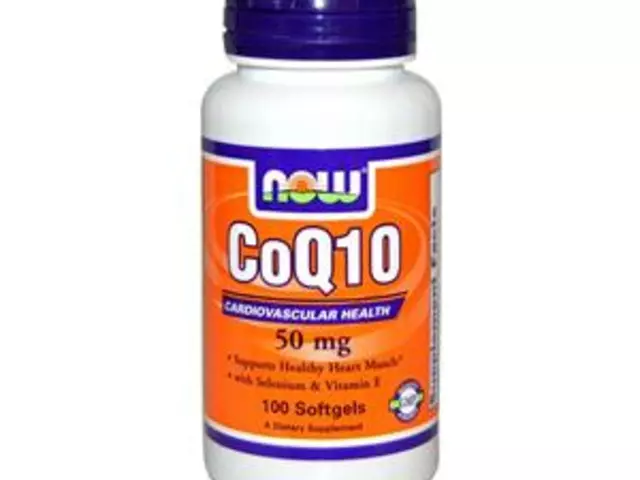

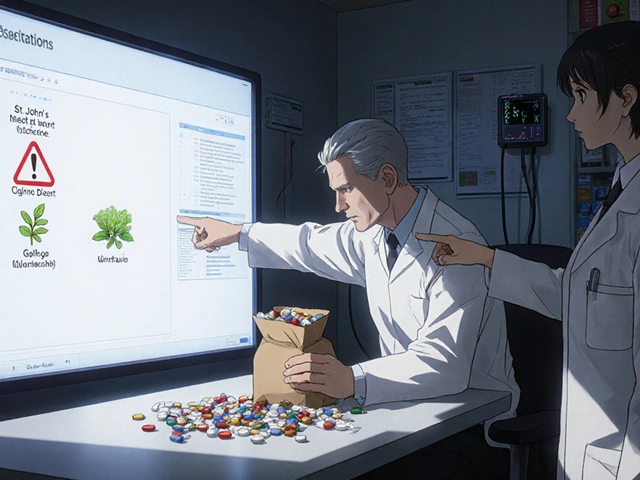
Jillian Bell
October 3, 2025 AT 06:47Can't trust the big pharma that pushes Rogaine as the miracle cure; they want you locked into a monthly subscription while the generic does the same job for a third of the price. The additives in the branded foam are just filler to keep the profit margins high, and the side‑effect profile is identical because the active ingredient is unchanged. If you buy the generic you avoid the marketing hype and the hidden chemicals that supposedly “enhance absorption.” Remember, the FDA only regulates the amount of minoxidil, not the proprietary base. So before you hand over $45 a month, ask yourself who really benefits.
Lindsey Bollig
October 10, 2025 AT 05:27Great rundown! If you're on a budget, the generic minoxidil is a solid start and you can still see noticeable regrowth after a few months. Pair it with a gentle shampoo and avoid over‑washing to keep the scalp healthy. Stick with it for at least 12 weeks before judging the results, and you'll have a clearer picture of what works for you.
Daniel Buchanan
October 17, 2025 AT 04:07Everyone’s hair journey is different, so don’t feel pressured to pick the most aggressive option right away. Starting with a topical like minoxidil lets you test your scalp’s response without systemic side effects. If you later decide you need more boost, adding a low dose of finasteride can be discussed with a doctor. The key is consistent application and patience.
Lena Williams
October 24, 2025 AT 02:47i was lookin at the chart and honestly the cost difference between rogaine and the generic is insane, like $30 more each month for basically the same stuff. sure the foam might feel less greasy but you can just let the liquid dry a bit longer and it works just fine. also, ppl forget that you can buy a big bottle of the generic and save even more over a year. i’ve tried both and didn’t notice any big diff in hair density, just the packaging. so if you’re tryna save some cash, go generic and dont overthink it.
Sierra Bagstad
October 31, 2025 AT 01:27The data indicates that both Rogaine and generic minoxidil exhibit an effectiveness rating of 3.5/5, reflecting a typical 10‑20% increase in hair count after 12 weeks. Side‑effect scores are identical at 2.0/5, primarily involving scalp irritation. Consequently, the primary differentiator is cost, with the generic averaging $15 per month versus $45 for the branded version.
Alan Kogosowski
November 7, 2025 AT 00:07When evaluating hair‑loss therapeutics, it is essential to adopt a systematic approach that accounts for pharmacodynamics, patient adherence, and cost‑effectiveness. Minoxidil, whether marketed as Rogaine or sold as a generic, functions as a vasodilator that enhances perifollicular blood flow, thereby extending the anagen phase of the hair cycle. Clinical trials consistently demonstrate that roughly 40‑60% of male participants experience measurable regrowth, yet the magnitude of that regrowth rarely exceeds a 20% increase in follicular density. The vehicle, whether foam or liquid, plays a secondary role; its primary purpose is to facilitate dermal absorption while minimizing irritation. Studies comparing foam to liquid formulations have shown no statistically significant difference in efficacy, though some users report a subjective preference for foam due to reduced greasiness. From an economic standpoint, the generic formulation offers a three‑fold cost reduction, which translates into substantial savings over a typical two‑year treatment horizon. Moreover, the lower price point may improve long‑term adherence, as patients are less likely to discontinue therapy due to financial strain. Conversely, brand loyalty can be driven by perceived quality, and for some individuals, the psychological reassurance of using a name‑brand product enhances compliance. Nonetheless, it is critical to recognize that the active ingredient concentration-5% minoxidil-is identical across both products, rendering the pharmacological impact equivalent. When juxtaposed with finasteride, which exerts its effect by inhibiting 5‑alpha‑reductase, minoxidil offers a more localized mechanism with a comparatively benign systemic side‑effect profile. Finasteride’s higher effectiveness rating of 4.5/5 must be weighed against its heightened side‑effect rating of 3.5/5, which includes potential sexual dysfunction and mood alterations. Patients must therefore engage in shared decision‑making with their clinician, evaluating both the magnitude of expected hair regrowth and their tolerance for possible adverse events. Additionally, emerging modalities such as low‑level laser therapy present a non‑pharmacological alternative, albeit with a higher upfront cost and modest efficacy. In the broader therapeutic landscape, it is evident that there is no universally optimal solution; rather, treatment selection should be individualized based on the patient’s pattern of hair loss, budgetary constraints, and personal risk tolerance. Ultimately, the decision matrix provided in the article serves as a valuable heuristic, guiding patients toward a regimen that aligns with both their clinical needs and lifestyle preferences.
Ben Lee
November 13, 2025 AT 22:47I’ve seen a lot of folks start with minoxidil alone and get decent results, then add finasteride later for that extra push. The combo tends to give you a steadier, thicker growth, especially on the crown. Just keep an eye on any scalp irritation when you layer the products, and give each one a few weeks to settle in before tweaking the dosage.
David Brice
November 20, 2025 AT 21:27Look, if u cant afford the $45 ROGAINE then just buy the cheap generic and stop whining about “brand quality”. The only real reason people pay extra is cuz the marketing peeps fed them hype. Stop the drama and just try the cheaper stuff – it works the same.
Zachary Schroer
November 27, 2025 AT 20:07Rogaine is just a cash grab 🙄
Stacy Whitman
December 4, 2025 AT 18:47American men should support home‑grown solutions instead of relying on foreign pharma giants. The generic is made locally and keeps our wallets safe.